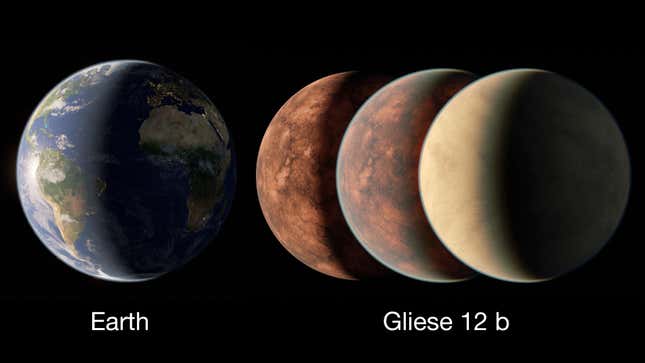A newly discovered exoplanet, with its surface temperature estimated to be remarkably temperate, is suddenly one of the most intriguing objects in our immediate celestial neighborhood. This rocky Venus-sized world transits a red dwarf star, offering astronomers the rare opportunity to study whether such planets can retain their atmospheres and potentially support life.
Gliese 12 b, comparable in size to Venus but slightly smaller than Earth, orbits its cool red dwarf host star, Gliese 12, at just 7% of the distance between Earth and the Sun. This unnervingly close proximity results in a year lasting just 12.8 days and the planet receiving 1.6 times more energy from its star than Earth does from the Sun. Despite this, Gliese 12 b maintains an estimated surface temperature of 107 degrees F (42 degrees C), making it a temperate world and one of the cooler exoplanets discovered so far, according to new research published today in the Monthly Notices of the Royal Astronomical Society. By comparison, Earth has an average surface temperature of 59 degrees F (15 degrees C), but it’s rising due to human-induced climate change.
Advertisement
The next big steps are for astronomers to figure out whether Gilese 12 b, located 40 light-years from Earth, hosts an atmosphere, and if so what type, and whether this planet is capable of hosting stable liquid water—the prerequisite for life as we know it—at the surface. “Gliese 12 b represents one of the best targets to study whether Earth-size planets orbiting cool stars can retain their atmospheres, a crucial step to advance our understanding of habitability on planets across our galaxy,” Shishir Dholakia, a doctoral student at the Centre for Astrophysics at the University of Southern Queensland in Australia, explained in an emailed statement.

Advertisement
The host star, Gliese 12, is about 27% the size of our Sun and has a surface temperature that’s around 60% of that of our host star. Unlike many red dwarfs, which are known for their magnetic activity and frequent, powerful X-ray flares, Gliese 12 shows no signs of such extreme behavior, raising hopes that Gliese 12 b’s atmosphere might still be intact, according to the astronomers.
The exoplanet’s atmosphere (which may or may not exist) will be a primary focus of future studies, particularly with the James Webb Telescope, which is well-suited for analyzing the chemical composition of planetary atmospheres through its advanced infrared capabilities. Gliese 12 b, being a transiting exoplanet, frequently passes in front of its host star from our perspective on Earth, allowing detailed observations through transit spectroscopy. This method enables astronomers to study the light filtered through the planet’s atmosphere, revealing the presence of various gasses and potential indicators of habitability.
Advertisement
“Although we don’t yet know whether it possesses an atmosphere, we’ve been thinking of it as an exo-Venus, with similar size and energy received from its star as our planetary neighbour in the solar system,” said Masayuki Kuzuhara, a project assistant professor at the Astrobiology Center in Tokyo. To which he added: “We’ve found the nearest, transiting, temperate, Earth-size world located to date.”
Advertisement
The planet’s location and characteristics could provide insights into why Earth and Venus, despite their similarities, have vastly different atmospheres. As Dholakia explained: “Atmospheres trap heat and—depending on the type [of atmosphere]—can change the actual surface temperature substantially.”
In the study, the researchers refer to the exoplanet’s “equilibrium temperature,” which is how hot it would be without an atmosphere. The main scientific interest in Gliese 12 b is to understand what kind of atmosphere it might have; ideally, it would have an atmosphere like Earth, and not the thick, toxic clouds of sulfuric acid found on Venus, where surface temperatures reach over 860 degrees F (450 degrees C). Because it gets a similar amount of light as Earth and Venus, studying it can help us learn more about the differences between these two planets in our solar system, according to Dholakia.
Advertisement
The researchers used NASA’s Transiting Exoplanet Survey Satellite (TESS) and the European Space Agency’s CHEOPS (CHaracterising ExOPlanets Satellite) to estimate the equilibrium temperature of Gliese 12 b. TESS initially detected the planet by observing its transits, which are periodic dips in starlight caused by the planet passing in front of its host star. These observations were then followed up with more precise measurements from CHEOPS, which helped refine the planet’s orbital period and radius. The combined data from TESS and CHEOPS allowed the researchers to calculate the equilibrium temperature by assessing the amount of starlight the planet receives and its distance from the star. The project was a collaborative effort between teams from the University of Southern Queensland, the University of Edinburgh, and the Astrobiology Center at the University of Tokyo.
The significance of this discovery extends beyond our solar system. It may help show whether most stars in our Milky Way, which are cool red dwarfs, can host temperate planets with atmospheres, making them potentially habitable. Research from 2013 suggested that as many as 4.5 billion potentially habitable planets may orbit around red dwarfs in our galaxy, but evidence to support this has been scant to non-existent.
Related article: How life could survive on exoplanet Proxima b
Gliese 12 b’s discovery highlights the progress astronomers are making in the search for habitable worlds. While Proxima Centauri b, the closest Earth-like exoplanet at just 4 light-years away, remains less understood due to its non-transiting nature, Gliese 12 b’s transiting behavior provides a clearer path for atmospheric studies. This advantage will hopefully allow scientists to gain better insights into its potential habitability.
Advertisement
As research continues to advance, Gliese 12 b could play a pivotal role in our quest to understand the conditions necessary for life beyond our solar system.
More: The Real Physics Behind Netflix’s 3 Body Problem
Services Marketplace – Listings, Bookings & Reviews